Allen Tiller's Blog, page 27
April 17, 2019
Ghosts of the Barossa - Barossa History Fair
Ghosts of the Barossa - Barossa History Fair
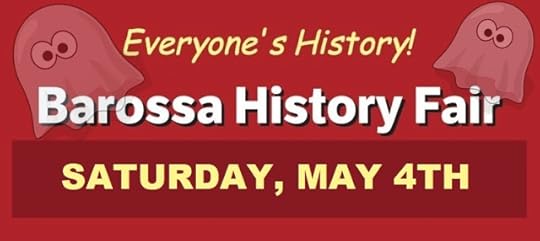
Got a ghost story from the Barossa Valley, or want more information about hauntings in the Barossa Region?
Historian, Genealogist and TV presenter from Haunting: Australia and paranormal investigator Allen Tiller will be hosting a "Ghosts of the Barossa" stall at this years Barossa History Fair.
Allen will also be available to record and preserve any local ghost stories that are brought to his attention on the day!
Allen has also agreed to present a talk on ghosts in and around the Barossa Valley! But seats will be very limited, so you'll need to make a reservation.
More info on the Barossa History Fair: INFORMATION
Barossa History Fair - 12 noon until 4pm
Coulthard House, 66-70 Murray Street, Nuriootpa SA 5355
To host a stall at the fair or become an event sponsor, please contact Chris Murphy via email on historyfair@go2wo.com or 0413 113 089.
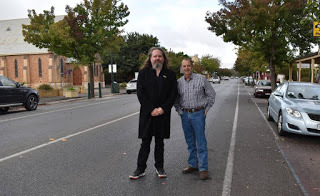 Historian, Allen Tiller from The Haunts of Adelaide
Historian, Allen Tiller from The Haunts of Adelaide
with Barossa History Fair organiser Chris Murphy in Nuriootpa,
who look forward to the free event in May.
photo: Michelle ORielly
Barossa Herald Story: https://www.barossaherald.com.au/story/5984755/haunts-feature-in-barossa-history-fair/?cs=1430&fbclid=IwAR2L4Oi_wcbIkF1xgjlRF17Pv8aetu1bq_i2L-xIBnAK3caRO-fDH95MkNM

Got a ghost story from the Barossa Valley, or want more information about hauntings in the Barossa Region?
Historian, Genealogist and TV presenter from Haunting: Australia and paranormal investigator Allen Tiller will be hosting a "Ghosts of the Barossa" stall at this years Barossa History Fair.
Allen will also be available to record and preserve any local ghost stories that are brought to his attention on the day!
Allen has also agreed to present a talk on ghosts in and around the Barossa Valley! But seats will be very limited, so you'll need to make a reservation.
More info on the Barossa History Fair: INFORMATION
Barossa History Fair - 12 noon until 4pm
Coulthard House, 66-70 Murray Street, Nuriootpa SA 5355
To host a stall at the fair or become an event sponsor, please contact Chris Murphy via email on historyfair@go2wo.com or 0413 113 089.
 Historian, Allen Tiller from The Haunts of Adelaide
Historian, Allen Tiller from The Haunts of Adelaide with Barossa History Fair organiser Chris Murphy in Nuriootpa,
who look forward to the free event in May.
photo: Michelle ORielly
Barossa Herald Story: https://www.barossaherald.com.au/story/5984755/haunts-feature-in-barossa-history-fair/?cs=1430&fbclid=IwAR2L4Oi_wcbIkF1xgjlRF17Pv8aetu1bq_i2L-xIBnAK3caRO-fDH95MkNM
Published on April 17, 2019 21:50
People, Places & Ghosts: A History of Salisbury & Surrounds
People, Places & Ghosts: A History of Salisbury & Surrounds
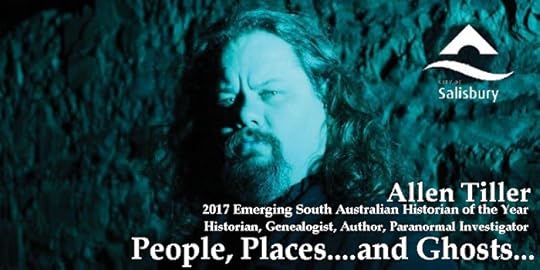
Celebrate History Month with nostalgia, history and a ghost story or two with South Australia’s award-winning paranormal historian Allen Tiller.
Step back in time as Allen presents a nostalgic look at some of Salisbury's most notable places, buildings and people whilst showcasing photos from the Salisbury Local History CollectionLight refreshments provided.Date And TimeThu., 9 May 2019, 6:00 pm ACSTLocationPara Hills Community Hub
22 Wilkinson Road
Para Hills, SA 5096
TICKETS: $5https://www.eventbrite.com.au/e/people-placesand-ghosts-a-history-of-salisbury-and-surrounds-tickets-56083781099?fbclid=IwAR1Tc4uQj9Dw7lSAWb4EtngfEPGmuvV4eRddy7dxt-jxSywMoMY_5fkhlng

Celebrate History Month with nostalgia, history and a ghost story or two with South Australia’s award-winning paranormal historian Allen Tiller.
Step back in time as Allen presents a nostalgic look at some of Salisbury's most notable places, buildings and people whilst showcasing photos from the Salisbury Local History CollectionLight refreshments provided.Date And TimeThu., 9 May 2019, 6:00 pm ACSTLocationPara Hills Community Hub
22 Wilkinson Road
Para Hills, SA 5096
TICKETS: $5https://www.eventbrite.com.au/e/people-placesand-ghosts-a-history-of-salisbury-and-surrounds-tickets-56083781099?fbclid=IwAR1Tc4uQj9Dw7lSAWb4EtngfEPGmuvV4eRddy7dxt-jxSywMoMY_5fkhlng
Published on April 17, 2019 21:40
April 16, 2019
Ghosts of the Barossa: The Ghost of Travus Klinkwort
The Ghost of Travus Klinkwort
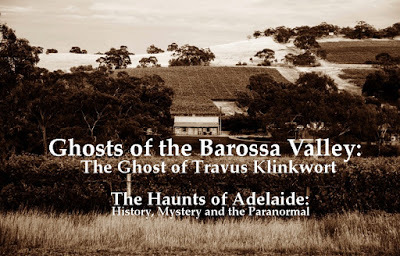
Just 6kms from the western Barossa Valley town of Greenock sits an old ruined homestead in a field. The house was lived in by the Klinkworts who had to Australia from Hanover Germany and settled in the region, establishing their farm. The couple had two daughters, Josia and Esther. Travus was a hardworking man, who was known locally as a hard worker but with a mean streak, and often, people would state he was a cold and heartless man. Sadly, Travus’ wife passed away, and he was left to run the farm and raise his daughters.Travus was a harsh man. He worked his daughters hard and allowed them no pleasures in life. Their only social interactions away from the farm occurred at church. They came to resent and fear their father. The girls soon reached maturity, and curiosity about the other sex soon overcame their raging hormones. One night, Josia invited a young local boy named Randall out to the farm. The girls had lied to their father and said they were going for a walk around their farm. Instead, Esther stood watch between the house and the field, while Josia and Randall explored each other in the field. Travus sat in the house. He grew suspicious of the girl's claims and grabbed a double-barrelled shotgun. He left the house, and under the moonlight, spotted Esther. He headed toward her quietly, then rushed forward as he drew clearer. Esther cried out to her sister. Josia and Randall jumped up and tried to get their clothes back on. Two almighty booms rang out across the field as Travus fired both shots from his gun. Josia and Randall were never seen in town again.
The following season, Travus had the biggest and best potato crop in the region. Rumours began to spread throughout the town, but nothing could be proven. Esther, forced by her father to keep the family secret, became a deranged and crazy old spinster, who eventually lived, and died by herself at the farm. In recent years, many people have been to the old homestead to take photographs. Most don’t know the history of the house, but many have reported the image of a man appearing in their photographs of the home.
One witness, a real estate agent, reported that he had visited the property when he been driving past. He saw it as a potential saleable property and decided to go have a look inside the building. He casually walked through, and all was quiet. He suddenly heard a low growl sound, much like a dog ready to attacks make, and became scared.
He was relieved though, to turn and see a man standing in the room too, with the sound coming from him. He looked at the man, an older gentleman wearing a torn great coat, baggy trousers and a battered old hat. The man continued to growl. The growl suddenly filled the room, as if it was coming from everywhere, and with it, a smell of rotting potatoes assaulted the agent’s nostrils. Then, suddenly, the man raised an ancient shotgun at the real estate agents head, and with a small click, and a mighty bang fired it at him.
As the flash of the blast filled the room with light, the estate agent thought he was done for, but in another instant, the room was empty and silent. The estate agent ran back to his car never to return.
Researched and written by Allen Tiller © 2019
This story first surfaced in Valerie Laughtons'True Barossa Ghost's book, in which she stated that she changed the names of the people involved.
References:
Davis, Richard & Davis, Richard Michael, (editor.) 2014, Great Australian ghost stories, ABC books, HarperCollins Publishers, Sydney, N.S.W
Laughton, Valerie Joy & Falkenberg, Darren, (photographer.) 1991, Valerie J. Laughton's true Barossa ghosts (gathered together with good spirits), Laughton, Nurioopta, S. Aust

Just 6kms from the western Barossa Valley town of Greenock sits an old ruined homestead in a field. The house was lived in by the Klinkworts who had to Australia from Hanover Germany and settled in the region, establishing their farm. The couple had two daughters, Josia and Esther. Travus was a hardworking man, who was known locally as a hard worker but with a mean streak, and often, people would state he was a cold and heartless man. Sadly, Travus’ wife passed away, and he was left to run the farm and raise his daughters.Travus was a harsh man. He worked his daughters hard and allowed them no pleasures in life. Their only social interactions away from the farm occurred at church. They came to resent and fear their father. The girls soon reached maturity, and curiosity about the other sex soon overcame their raging hormones. One night, Josia invited a young local boy named Randall out to the farm. The girls had lied to their father and said they were going for a walk around their farm. Instead, Esther stood watch between the house and the field, while Josia and Randall explored each other in the field. Travus sat in the house. He grew suspicious of the girl's claims and grabbed a double-barrelled shotgun. He left the house, and under the moonlight, spotted Esther. He headed toward her quietly, then rushed forward as he drew clearer. Esther cried out to her sister. Josia and Randall jumped up and tried to get their clothes back on. Two almighty booms rang out across the field as Travus fired both shots from his gun. Josia and Randall were never seen in town again.
The following season, Travus had the biggest and best potato crop in the region. Rumours began to spread throughout the town, but nothing could be proven. Esther, forced by her father to keep the family secret, became a deranged and crazy old spinster, who eventually lived, and died by herself at the farm. In recent years, many people have been to the old homestead to take photographs. Most don’t know the history of the house, but many have reported the image of a man appearing in their photographs of the home.
One witness, a real estate agent, reported that he had visited the property when he been driving past. He saw it as a potential saleable property and decided to go have a look inside the building. He casually walked through, and all was quiet. He suddenly heard a low growl sound, much like a dog ready to attacks make, and became scared.
He was relieved though, to turn and see a man standing in the room too, with the sound coming from him. He looked at the man, an older gentleman wearing a torn great coat, baggy trousers and a battered old hat. The man continued to growl. The growl suddenly filled the room, as if it was coming from everywhere, and with it, a smell of rotting potatoes assaulted the agent’s nostrils. Then, suddenly, the man raised an ancient shotgun at the real estate agents head, and with a small click, and a mighty bang fired it at him.
As the flash of the blast filled the room with light, the estate agent thought he was done for, but in another instant, the room was empty and silent. The estate agent ran back to his car never to return.
Researched and written by Allen Tiller © 2019
This story first surfaced in Valerie Laughtons'True Barossa Ghost's book, in which she stated that she changed the names of the people involved.
References:
Davis, Richard & Davis, Richard Michael, (editor.) 2014, Great Australian ghost stories, ABC books, HarperCollins Publishers, Sydney, N.S.W
Laughton, Valerie Joy & Falkenberg, Darren, (photographer.) 1991, Valerie J. Laughton's true Barossa ghosts (gathered together with good spirits), Laughton, Nurioopta, S. Aust
Published on April 16, 2019 03:00
April 9, 2019
Munno Para West District Council Office – 9 Adelaide Road
Munno Para West District Council Office – 9 Adelaide Road
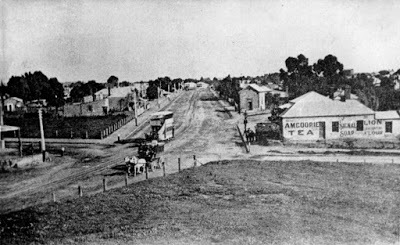
<Transcript>If you live in Gawler you’ve probably driven past the little building on the corner of Adelaide Road and Twelfth Street a thousand times but never given it a second thought.
Currently, the building is Creative Outdoors Display Centre, previously it has been used a second-hand store, and a tax agent, but none of these were its original purpose.Bound in the south by the Little Para River, in the North by the Gawler River, The District Council of Munno Para West Was formed in 1854, a year after the District Council of Munno Para East was formed.
The council included the towns of Virginia, Smithfield, Penfield, Angle Vale, St Kilda and Gawler Blocks. Gawler Blocks were later to be known as Gawler South and removed from the District Council of Munno Para west in 1899.The District Councils of Munno Para East & West were united to become the City of Munno Para in 1933, with some sections going to the Town of Gawler, and others going to the District Council of Salisbury, the rest were merged with the Munno Para East Council.
The building that stands today was originally built to be a chapel in 1855, however it was bought in 1861 to become the District Council of Munno Para West’s head office, whilst the District Council of Munno Para’s East office was in Murray Street Gawler – you may recognise it as the building currently next door to Elders.
<End Transcript>
Since publishing this video, I have been informed that this small building was the home the home of a family of ten during the 1950/60s. It has also been used as a computer store (information supplied by Robby Cummins)
Researched and written by Allen Tiller ©2019

<Transcript>If you live in Gawler you’ve probably driven past the little building on the corner of Adelaide Road and Twelfth Street a thousand times but never given it a second thought.
Currently, the building is Creative Outdoors Display Centre, previously it has been used a second-hand store, and a tax agent, but none of these were its original purpose.Bound in the south by the Little Para River, in the North by the Gawler River, The District Council of Munno Para West Was formed in 1854, a year after the District Council of Munno Para East was formed.
The council included the towns of Virginia, Smithfield, Penfield, Angle Vale, St Kilda and Gawler Blocks. Gawler Blocks were later to be known as Gawler South and removed from the District Council of Munno Para west in 1899.The District Councils of Munno Para East & West were united to become the City of Munno Para in 1933, with some sections going to the Town of Gawler, and others going to the District Council of Salisbury, the rest were merged with the Munno Para East Council.
The building that stands today was originally built to be a chapel in 1855, however it was bought in 1861 to become the District Council of Munno Para West’s head office, whilst the District Council of Munno Para’s East office was in Murray Street Gawler – you may recognise it as the building currently next door to Elders.
<End Transcript>
Since publishing this video, I have been informed that this small building was the home the home of a family of ten during the 1950/60s. It has also been used as a computer store (information supplied by Robby Cummins)
Researched and written by Allen Tiller ©2019
Published on April 09, 2019 03:00
April 2, 2019
Buckerfield's Mill Inn
Buckerfield's Mill Inn
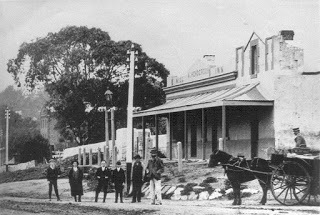
< Transcript> The earliest records of the Mill Inn on the corner of Adelaide Road and Seventh Street Gawler South are from 1858, with the hotel license being registered to Mr H.W. Buckerfield in 1859. Buckerfield’s Mill Inn, as it became known, was a very popular drinking venue in the town, and also known for having 1st class accommodation. Buckerfield added stockyards to his substantial property in 1864.
Buckerfields Mill Inn was known in Gawler as the home of sporting events. It sponsored many local horse races, sprinting races at Goose Island, and Rifle Shooting competitions.Buckerfield sold the hotel to Mr C Woltmann in 1866, and from then on it changed hands another 24 times until 1920 when its liquor license was finally withdrawn.
In 1882, 48-year-old Charles Daniels, left the Mill Inn to walk across the Mill Bridge, only to be struck down by the 10:30 pm horse-drawn tram from the Gawler Railway Station. Daniels injuries were substantial after being crushed by the tram’s wheels, and he died not long after the accident.In 1904, while under the license of Edward Maher, local life assurance agent, Percy Webb committed suicide in the hotels' stables. In 1907, William Thomas was charged with causing a disturbance at the hotel for getting very drunk and not being able to pay his bill. For using indecent language against the arresting officer, he received 14 days in her Majesty’s Adelaide Gaol! Two other patrons, Mr and Mrs Yeomen were fined for obstructing police.
Also, in 1970, 19-year-old William Goldney, who was riding his bike across the Mill Bridge, was clipped by a horse and trap. Goldney was taken to the Mill Inn where he died from his injuries two hours later.In 1920 the hotel closed its doors for the final time. A large auction was held to sell the hotels goods, which attracted a large crowd.
From 1923 the former Mill Inn became the home of Mrs Broadstock, and during the 1960s, it became a deli. In the late 1970s and early 1980s, it became a Vincentian Centre, part of the St Vincent DePaul SocietyMost recently Hyde and Partners have renovated the building and neighbouring house and created their Medical Centre.
<End Transcript>
Correction: In the video, I refer to W.H. Buckerfield as being the first owner of the hotel when in fact it was H.W. Buckerfield that owned it.
William Henry Buckerfield owned the Angaston Hotel, and his son Henry William Buckerfield owned the Mill Inn, Gawler.
Researched and written by Allen Tiller ©2019

< Transcript> The earliest records of the Mill Inn on the corner of Adelaide Road and Seventh Street Gawler South are from 1858, with the hotel license being registered to Mr H.W. Buckerfield in 1859. Buckerfield’s Mill Inn, as it became known, was a very popular drinking venue in the town, and also known for having 1st class accommodation. Buckerfield added stockyards to his substantial property in 1864.
Buckerfields Mill Inn was known in Gawler as the home of sporting events. It sponsored many local horse races, sprinting races at Goose Island, and Rifle Shooting competitions.Buckerfield sold the hotel to Mr C Woltmann in 1866, and from then on it changed hands another 24 times until 1920 when its liquor license was finally withdrawn.
In 1882, 48-year-old Charles Daniels, left the Mill Inn to walk across the Mill Bridge, only to be struck down by the 10:30 pm horse-drawn tram from the Gawler Railway Station. Daniels injuries were substantial after being crushed by the tram’s wheels, and he died not long after the accident.In 1904, while under the license of Edward Maher, local life assurance agent, Percy Webb committed suicide in the hotels' stables. In 1907, William Thomas was charged with causing a disturbance at the hotel for getting very drunk and not being able to pay his bill. For using indecent language against the arresting officer, he received 14 days in her Majesty’s Adelaide Gaol! Two other patrons, Mr and Mrs Yeomen were fined for obstructing police.
Also, in 1970, 19-year-old William Goldney, who was riding his bike across the Mill Bridge, was clipped by a horse and trap. Goldney was taken to the Mill Inn where he died from his injuries two hours later.In 1920 the hotel closed its doors for the final time. A large auction was held to sell the hotels goods, which attracted a large crowd.
From 1923 the former Mill Inn became the home of Mrs Broadstock, and during the 1960s, it became a deli. In the late 1970s and early 1980s, it became a Vincentian Centre, part of the St Vincent DePaul SocietyMost recently Hyde and Partners have renovated the building and neighbouring house and created their Medical Centre.
<End Transcript>
Correction: In the video, I refer to W.H. Buckerfield as being the first owner of the hotel when in fact it was H.W. Buckerfield that owned it.
William Henry Buckerfield owned the Angaston Hotel, and his son Henry William Buckerfield owned the Mill Inn, Gawler.
Researched and written by Allen Tiller ©2019
Published on April 02, 2019 02:00
April 1, 2019
Barossa Elephant Walk
Barossa Elephant Walk
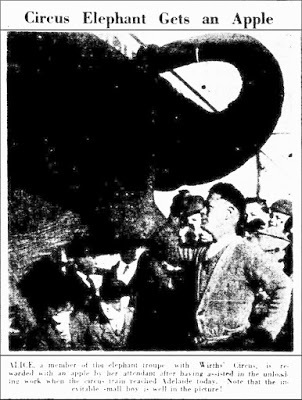 1933, world travelling Wirth Brothers Circus had just finished shows in Adelaide and Gawler, and July 7th scheduled shows for Angaston in the Barossa Valley.
1933, world travelling Wirth Brothers Circus had just finished shows in Adelaide and Gawler, and July 7th scheduled shows for Angaston in the Barossa Valley.
During the Gawler show of the circus, spectators commented on how the elephants didn’t seem to wander far from the circus troop, and how, if they did, they could cause significant damage to a small town. These statements may have foretold future events!
The following week, while Wirth’s Circus was in Angaston, one of the elephants decided he would go for a walk through the town. The lone elephant found himself in the garden of Mr Hentschke. It knocked over Mr Hentschke’s fences, then pulled up some of his roses. The elephant, not content with his destruction, then pulled a much-prized plum tree from the ground.
The elephant stomped its way through Hentschke’s prized garden, and once it had finished its rampage, took one of Hentschke’s wicker chairs from the front veranda and obliterated it, throwing it, in tiny pieces, across the front yard.
After its outing, the elephant returned to the circus.
One has to wonder if the same elephant was the cause of destruction in nearby Tanunda, where a number of grapevines were pulled from the ground. This elephant was shooed away by workers and returned to its circus!
Researched and written by Allen Tiller © 2019
References:
1933 'ELEPHANT WANDERS OFF', Leader (Angaston, SA: 1918 - 1954), 20 July, p. 2. , viewed 25 Mar 2019, http://nla.gov.au/nla.news-article1656953711933 'Wirth Bros. Ltd. Circus', Leader (Angaston, SA: 1918 - 1954), 13 July, p. 1. , viewed 25 Mar 2019, http://nla.gov.au/nla.news-article1656959791933 '1-ELEPHANT POWER.', Bunyip (Gawler, SA: 1863 - 1954), 28 July, p. 4. , viewed 25 Mar 2019, http://nla.gov.au/nla.news-article96651993
 1933, world travelling Wirth Brothers Circus had just finished shows in Adelaide and Gawler, and July 7th scheduled shows for Angaston in the Barossa Valley.
1933, world travelling Wirth Brothers Circus had just finished shows in Adelaide and Gawler, and July 7th scheduled shows for Angaston in the Barossa Valley. During the Gawler show of the circus, spectators commented on how the elephants didn’t seem to wander far from the circus troop, and how, if they did, they could cause significant damage to a small town. These statements may have foretold future events!
The following week, while Wirth’s Circus was in Angaston, one of the elephants decided he would go for a walk through the town. The lone elephant found himself in the garden of Mr Hentschke. It knocked over Mr Hentschke’s fences, then pulled up some of his roses. The elephant, not content with his destruction, then pulled a much-prized plum tree from the ground.
The elephant stomped its way through Hentschke’s prized garden, and once it had finished its rampage, took one of Hentschke’s wicker chairs from the front veranda and obliterated it, throwing it, in tiny pieces, across the front yard.
After its outing, the elephant returned to the circus.
One has to wonder if the same elephant was the cause of destruction in nearby Tanunda, where a number of grapevines were pulled from the ground. This elephant was shooed away by workers and returned to its circus!
Researched and written by Allen Tiller © 2019
References:
1933 'ELEPHANT WANDERS OFF', Leader (Angaston, SA: 1918 - 1954), 20 July, p. 2. , viewed 25 Mar 2019, http://nla.gov.au/nla.news-article1656953711933 'Wirth Bros. Ltd. Circus', Leader (Angaston, SA: 1918 - 1954), 13 July, p. 1. , viewed 25 Mar 2019, http://nla.gov.au/nla.news-article1656959791933 '1-ELEPHANT POWER.', Bunyip (Gawler, SA: 1863 - 1954), 28 July, p. 4. , viewed 25 Mar 2019, http://nla.gov.au/nla.news-article96651993
Published on April 01, 2019 14:00
March 26, 2019
Sandilands Murder: Part IV: Conviction and Release
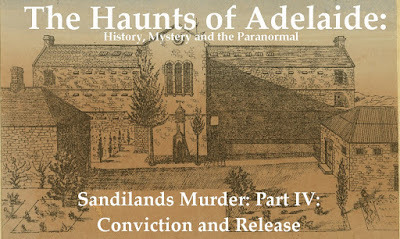 Sandilands Murder: Part IV: Conviction and Release
Sandilands Murder: Part IV: Conviction and Release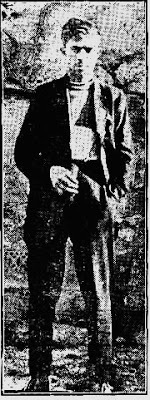 Herbert Cyril Curnow - after his arrestMounted Constable West of the Maitland Police Station first saw Curnow at 5:30pm when he entered the police station to hand himself in.
Herbert Cyril Curnow - after his arrestMounted Constable West of the Maitland Police Station first saw Curnow at 5:30pm when he entered the police station to hand himself in.Constable West asked Curnow if had “shot a girl named Eleanor Louise Bockmann at Sandilands this afternoon? “, which Curnow replied “Yes, how is she? Is she dead?”
The constable then proceeded to tell Curnow that she was dead and asked him what he shot her with. Curnow replied that it was with a 12-gauge shotgun. The gun was now in Mr Rowe's wheat paddock.
The constable searched Curnow and found in his pocket a spent 12-gauge shotgun shell and a photo of Eleanor Bockmann. He asked Curnow if it was the shell with which he shot Bockmann, and Curnow replied “yes”.
Constable West charged Curnow with murder.
Mounted Constable Ewens, stationed at Ardrossan received a message at 4:15 pm on Friday, September 8th, requesting him to go to the Sandilands home of the Bockmann family posthaste.
When the constable arrived at the family home he found Dr Alpers sitting in a bedroom with the deceased. Dr Alpers described her wounds to him before the constable then made an inspection of the house.
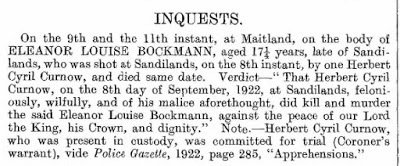 He found in a bedroom a box containing 12 gauge shotgun cartridges. In the dining room, near the window was a large pool of blood. The constable followed a trail of blood from the dining room, through the kitchen and enclosed verandah, then outside for nine yards, stopping just near the rainwater tank.
He found in a bedroom a box containing 12 gauge shotgun cartridges. In the dining room, near the window was a large pool of blood. The constable followed a trail of blood from the dining room, through the kitchen and enclosed verandah, then outside for nine yards, stopping just near the rainwater tank.The wall and chairs in the dining room were covered in small holes consistent with shotgun pellet spray.
The Constable travelled over to Rowes farm and located the gun in a paddock. M.C. West and M.C. Ewens both travelled to the paddock the following day and recovered a number of unspent shotgun shells.
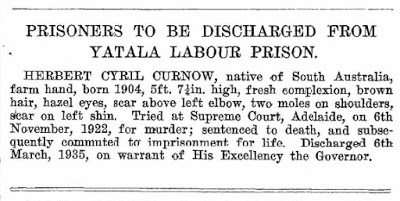 When appearing in court, Curnow seemed indifferent to what was going on around him. He was wearing football boots and a football Guernsey under a jacket and refused to speak. Members of the Bockmann family offered their evidence.
When appearing in court, Curnow seemed indifferent to what was going on around him. He was wearing football boots and a football Guernsey under a jacket and refused to speak. Members of the Bockmann family offered their evidence.Curnow was formerly committed for trial at the close of the Coronial Enquiry. The following morning Curnow was officially charged with Wilful Murder.
The trial proceeded in Adelaide. It did not take long for the jury to find Curnow guilty of murder. He was sentenced to hang, with the date chosen to be two days after Christmas in 1922. Curnow's lawyer appealed for mercy, due to his young age, but it fell on deaf ears.
Within days, supporters for Curnow pleaded for mercy for the 18-year-old. A Parliamentary enquiry proceeded, and after their investigation, Curnow's sentence was reduced to life in Yatala Prison with hard labour.
But, Curnow's story doesn’t end there. In 1935, after many petitions to the Government on his behalf, prison officials decided to release Curnow. He was released from Yatala Stockade in February 1935 and sent to live in Melbourne with family.
After that, the trail left by Curnow becomes harder to follow…reports are inconsistent, with some saying he died that year, others say he may have changed his name and lived out his life in Victoria.
Researched and written by Allen Tiller © 2019
References:
1922 'DEATH SENTENCE COMMUTED', Barrier Miner (Broken Hill, NSW: 1888 - 1954), 23 December, p. 2. (SPORTING EDITION), viewed 04 Jan 2019, http://nla.gov.au/nla.news-article45592974
1922 'DEATH SENTENCE COMMUTED', Kalgoorlie Miner (WA: 1895 - 1950), 23 December, p. 4. , viewed 04 Jan 2019, http://nla.gov.au/nla.news-article93227794
1922 'DEATH SENTENCE.', The Brisbane Courier (Qld. : 1864 - 1933), 30 November, p. 8. , viewed 04 Jan 2019, http://nla.gov.au/nla.news-article20586995
1922 'MAITLAND TRAGEDY.', The Register (Adelaide, SA: 1901 - 1929), 12 September, p. 9. , viewed 04 Jan 2019, http://nla.gov.au/nla.news-article64133604
1922 'THE MAITLAND MURDER.', The Advertiser (Adelaide, SA: 1889 - 1931), 30 November, p. 8. , viewed 04 Jan 2019, http://nla.gov.au/nla.news-article49131151
1922 'YOUTH GUILTY OF MURDER.', The Argus (Melbourne, Vic. : 1848 - 1957), 30 November, p. 9. , viewed 04 Jan 2019, http://nla.gov.au/nla.news-article1858876
1935 'Little Danger From Released Murderers', The Mail (Adelaide, SA: 1912 - 1954), 16 March, p. 2. , viewed 04 Jan 2019, http://nla.gov.au/nla.news-article58858507
South Australia Police Gazette Indexes, 1862-1947. Ridgehaven, South Australia: Gould Genealogy and History, 2009.
South Australia Police Gazette Indexes, 1862-1947. Ridgehaven, South Australia: Gould Genealogy and History, 2009. AU5103-1922 SA Police Gazette 1922
South Australia Police Gazette Indexes, 1862-1947. Ridgehaven, South Australia: Gould Genealogy and History, 2009. AU5103-1935 SA Police Gazette 1935
Published on March 26, 2019 02:00
March 19, 2019
Sandilands Murder Part III: “If I Had a Gun, I’d Shoot You, Then Myself!”
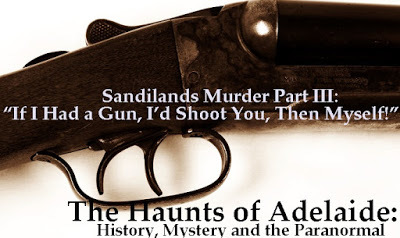
Sandilands Murder Part III: “If I Had a Gun, I’d Shoot You, Then Myself!”
Herbert Cyril Curnow, known to friends as Cyril, had previously made threats to Eleanor Bockmann. He had said to her, “If I had a knife, I would cut your throat, then my own.” On another occasion, he had said to the girl, "If I had a gun, I would shoot you, then myself!”.
On Thursday the 7th of September, Curnow waited on the Ardrossan road about three miles down from Sandilands. He knew Bockmann had to come this way to go to her sewing lessons. Curnow set up a barbed wire across the road, hoping to catch Bockmann in it. He went up onto a nearby hill, and waited for her, hoping to shoot her when she rode into the barbed wire.
he waited until nightfall, but Bockmann never rose through, so he returned to the Bockmann family home in Sandilands.
On Friday the 8th of September, Curnow, after kicking a football with Lawrence Bockmann, waited for Lawrence and his dad to go out into the paddocks and spread manure. He watched the two men go out and knowing Mrs Bockmann was not home, took advantage of the fact, and went and got the families gun. He cleaned the gun, loaded it, and put it near the kitchen door.
He went back into the bedroom and read. He went outside for a drink, and noticed the gun was gone. He told Eleanor Bockmann that her father said he could have the gun, and asked her to get it. She got the gun, he returned to the bedroom, gathered his belongings, then returned to the dining room where the girls were mending socks.
He checked the gun was loaded, raised the rifle, and aimed for Eleanors temple, fired the gun. The girls screamed, with Eleanor falling to the floor, and the other two girls running way in fear.
Curnow ran outside. He ran for two miles into the scrub, with the intention of giving himself up to Mr Rowe a nearby farmer. As he was running, a motor car came along, so Curnow threw the gun into a paddock, and hitched a lift to Maitland.
When in Maitland, Curnow went to the local police station and handed himself in.
Sandilands Murder Part IV: Conviction and Release
Researched and written by Allen Tiller © 2019
References in the final post.
Published on March 19, 2019 02:00
March 12, 2019
Sandilands Murder Part II: Wilful Murder
 Sandilands Murder Part II: Wilful MurderThirteen-year-old Gladys Bockmann was the first witness in the trial against Herbert Cyril Curnow for the murder of Eleanor Louise Bockmann. Gladys stated to the court, that on Friday the 8th of September the family sat down to lunch together, with Curnow present as he had been staying with the family during the local football finals, as he was on the same team as her brother Lawrence. After lunch, Curnow and Lawrence had gone outside to kick a football. He came back inside around twenty minutes later, and laid on the bed in her brother's room and read a book. At about 2:30pm, Curnow went outside to get a drink of water. He had come back inside with a gun.
Sandilands Murder Part II: Wilful MurderThirteen-year-old Gladys Bockmann was the first witness in the trial against Herbert Cyril Curnow for the murder of Eleanor Louise Bockmann. Gladys stated to the court, that on Friday the 8th of September the family sat down to lunch together, with Curnow present as he had been staying with the family during the local football finals, as he was on the same team as her brother Lawrence. After lunch, Curnow and Lawrence had gone outside to kick a football. He came back inside around twenty minutes later, and laid on the bed in her brother's room and read a book. At about 2:30pm, Curnow went outside to get a drink of water. He had come back inside with a gun.Gladys claimed that Eleanor said to them “let’s go up into the bedroom, he might shoot us!”. Gladys and Eleanor got up and went into their bedroom.
Curnow went outside again, and as he did Alvera called out to her cousins that he had left the house. Eleanor went out to the veranda taking the gun, coming back inside and hiding the gun in the house.
Curnow returned not long after and asked where the gun had gone. Gladys told Curnow she didn’t know where the gun was and called out to Eleanor to get it. Eleanor took the gun outside once again.
The girls gathered once again in the dining room, thinking that Curnow had gone down to the horse stables.Gladys then stated that she was sitting in the dining room with her sister Eleanor, and cousin Alvera darning socks.
Shortly after, Curnow returned, went into the boy's room for a few minutes, then came into the dining room. He had his hat and coat on and the gun in his hand. The girls, sitting around the sewing machine, watched in shock as, without a word, Curnow levelled the gun at them.
Alvera called out “Auntie!” and Curnow turned the gun toward Gladys, next he turned it toward Eleanor. Eleanor said “Don’t shoot me, Cyril!”, without saying a word, he pulled the trigger, then ran outside.Eleanor fell to the ground, she had been shot through the left side of her neck. Her head fell forward, then her hands came up and grabbed her neck. She ran outside.
Gladys ran outside to find her father and brother in a nearby paddock and screamed at them that Lorna (Eleanor) had been shot. They all jumped on their horse and cart and rushed back to the house.
Eleanor, now laying near the water tank of the house, died in her father's arms…
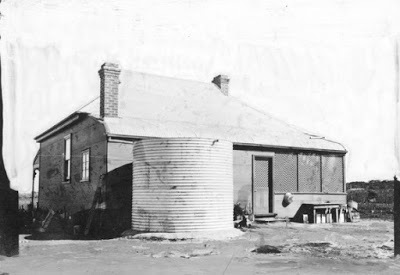 The back view of a house at Sandilands near Maitland, Yorke Peninsula, where 17-year-old Eleanor Louise Bockmann was murdered on 8 September 1922 by Herbert Cyril Curnow. The Observer newspaper reported "The home of the Bockmann's. The girl ran from the house and fell close to the galvanised-iron tank where she died in the arms of her father." SLSA: [PRG 280/1/32/167]Next Week: Sandilands Murder Part III: “If I Had a Gun, I’d Shoot You, Then Myself!”
The back view of a house at Sandilands near Maitland, Yorke Peninsula, where 17-year-old Eleanor Louise Bockmann was murdered on 8 September 1922 by Herbert Cyril Curnow. The Observer newspaper reported "The home of the Bockmann's. The girl ran from the house and fell close to the galvanised-iron tank where she died in the arms of her father." SLSA: [PRG 280/1/32/167]Next Week: Sandilands Murder Part III: “If I Had a Gun, I’d Shoot You, Then Myself!”
Researched and written by Allen Tiller © 2019
References in the final post.
Published on March 12, 2019 02:00
March 5, 2019
Sandilands Murder: Part I: Herbert Curnow and Eleanor Bockmann

Sandilands Murder: Part I: Herbert Curnow and Eleanor Bockmann
At 18 years old Herbert Cyril Curnow was a troubled young man from Moonta, South Australia. His father had been prone to explosive outbursts of anger that led to physical violence in the home. At the age of fourteen, Herbert had gone out on his own and found a job. He also played football in a local team. His other interest was reading about bushrangers and robberies, he studied these stories, and often imagined himself as a bushranger.
He had met the Bockmann’s only a few months previously through playing football and had started visiting the house to practice with the Bockmann brothers. While practising, he met 17-year-old Eleanor Bockmann. Within the coming weeks, the two became friendly, with Curnow accompanying Bockmann to Sunday School, Church and local dances.
Curnow fell hard for Bockmann, but she didn’t feel the same for him. Two months into their relationship they had begun to argue after Curnow saw Bockmann becoming friendly with other
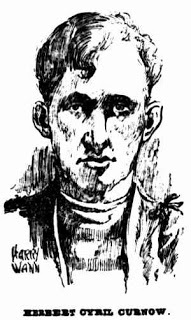 Artists impression of 18 year old
Artists impression of 18 year oldHerbert Cyril Curnowyoung men.
Curnow saw Bockmann walking along a local street with a drunk young man. The young man had his arm around Bockmann, which enraged Curnow. He confronted Bockmann, she replied, “If you don’t like it, you can lump it!”
The family went to church on September 3rd, with Curnow joining them. After church, Curnow and Bockmann had another argument. Bockmann broke of their relationship then and there, leaving Curnow devastated.
Bockmann then began to ignore Curnow at every opportunity. Curnow, on the other hand, could not stop thinking about her and found himself unable to sleep.
In the first week of September 1922, during local football finals, Curnow arranged to stay with the Bockmann family at Sandilands, near Maitland on the Yorke Peninsula. He shared the bedroom of the Bockmann brothers for the week and ate dinner with the family, including Eleanor.
His love for Eleanor had not subsided, and only intensified sharing the same house as her. On Friday the 8th of September, he ate lunch with the family and waited for Eleanor’s father to head back out to work, then he took his opportunity.
He took her fathers shotgun, entered the room, and shot her in the neck. Curnow then ran into the scrub, but eventually gave himself up to police.
Next Week: Sandilands Murder Part II: Wilful Murder
Researched and written by Allen Tiller © 2019
References in the final post.
Published on March 05, 2019 01:00



